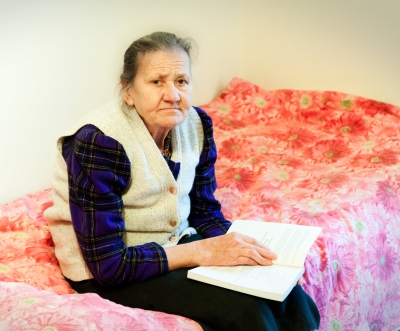
Photo credit: “Old Woman” by Graur Razvan Ionut, Freedigitalphotos.net
Calling for Violence-Free Nursing Homes
I have spent a great deal of my career working in care facilities for older adults. Although the name of this type of institution changes, the purpose for these types of facilities is always the same.
Nursing Homes, Residential Care Facilities, Supportive Housing, Personal Care Homes are terms used to describe facilitates and housing environments where older adults with physical and/or cognitive impairments are housed together in a communal setting. This is the “last resort” for many, as we know most people would prefer to live in their own homes. These “Homes” provide 24-hour care and supervision, and usually includes skilled nursing care.
Many people who live in these facilities have Alzheimer’s or some other related form of dementia (or neurocognitive disorder -that’s the new term now). Behaviour problems can result and sometimes residents who have dementia can cause harm to others, and sometimes it results in death. I have taken a particular interest in this subject and have studied and written on it.
I was thrilled when I saw an editorial written for JAMDA, calling for more research, policy and prevention in this area. Eilon Caspi, BSW, MA, PhD, writes “Deaths as a Result of Resident-to-Resident Altercations in Dementia in Long-Term Care Homes: A Need for Research, Policy and Prevention” in the Journal of the Medical Directors Association (January 2016). I also saw that Dr. Caspi had referenced our work on the “Seeking Action for Safety in Long-Term Care Facilities” advocacy and information website I maintain along with my social work colleagues Eleanor Silverberg and Victoria Brewster.
I invite you to join us in our quest to end violence in long-term care facilities. Please contact me if you have any concerns, questions or ideas.
Regards,
Angela G. Gentile, MSW, RSW

Wow. Good to be aware of.
Sent from my iPhone
>
LikeLike
I wanted to add that CPL took over the PCH where I worked later on as Social Worker. They asked a nurse and me I to research and report on what best practices would be part of the ideal “Special Needs Unit”. We drove to many Personal Care Homes to list the requirements for the ideal unit. Our report included: Units limited to 12 residents, enhanced staffing ratios, use of volunteers to provide one on one attention to residents, using only staff who freely chose to work in the Unit, private rooms, no shiny floors, no mirrors to confuse residents, no overhead announcements, exterior openings for deliveries so as not to disrupt residents, figure 8 walking paths in a safe enclosed outdoor area to enable residents to walk as much as they wished, circular walkways in hallways to enable residents to walk without running into a barrier, locked drawers for residents to keep possessions safely from other residents. Probably more that I’ve forgotten. I wish one unit with all these requirements could be developed as a pilot project.
LikeLike